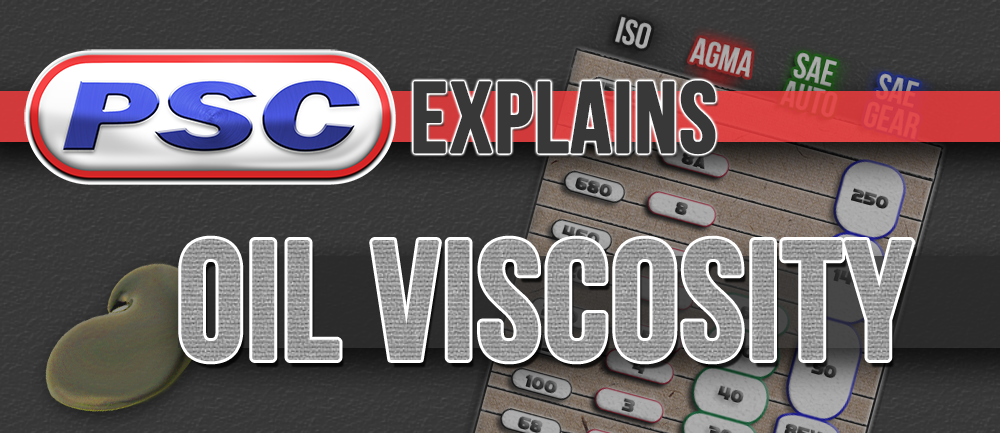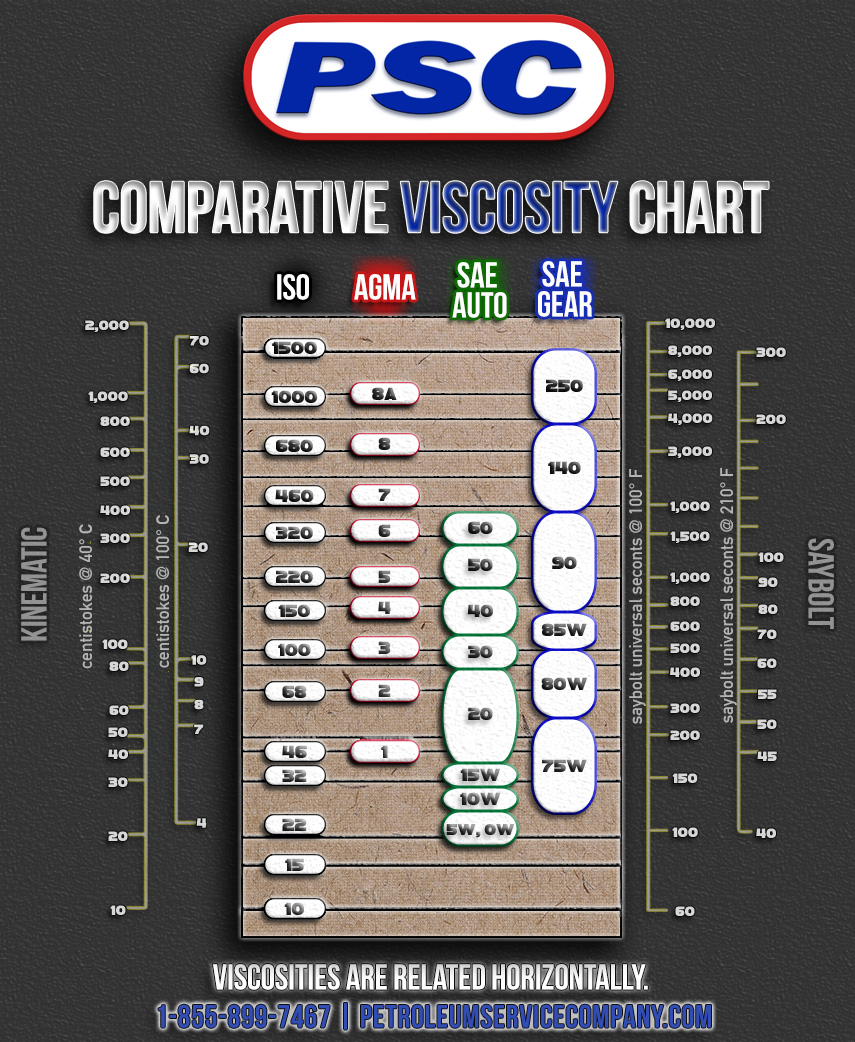What is Oil Viscosity? | Comparative Oil Viscosity Chart
By on Oct 06 2020

If you've changed your own oil before, then chances are you know what the "w" in 5w-20 means (HINT: it stands for winter grade, or rating).
But have you ever considered what the numbers in 5w-20 might signify? Or -- should you work with machinery that requires an industrial lubricant -- the AW-68 on your pail of hydraulic oil?
These numbers are representative of a lubricant's viscosity; and though the word may sound a bit dense, it's actually pretty simple: it is a number value for the relative thickness (or weight) of your oil or lubricant.

More precisely, viscosity is the measure of a fluid's resistance to flow (under certain conditions). In a nutshell, the thicker the fluid is, the more resistance to flow it will demonstrate.
Take, for example, this comparison of two common substances with different viscosities: water and honey. If you were to knock over a glass of water, the liquid would spill out immediately -- but a glass of honey would slowly spill over, giving you a second to react. This is because honey is more viscous than water and has a much higher viscosity.

Before we move on, consider honey when you heat it up: it immediately becomes easier to pour once it reaches a certain temperature; also, when cooled, the consistency of honey thickens. But what about water? Whether near freezing or just about to boil, water pours relatively the same. Liquid water has an extremely narrow viscosity spectrum (in the range of 33 F to 211 F) when compared with honey: meaning that the viscosity of water goes relatively unchanged over that temperature range; alternatively, honey would pour much slower at 33 F compared to 211 F, which means that its viscosity spectrum is much wider (in said temperature range).
When it comes to automotive engine lubrication, we often prefer oils with a low viscosity spectrum, but a "High Viscosity Index"-- in short, this means that the viscosity stays static over a wider range of temperatures; this occurs via unique additives referred to as "Viscosity Index Improvers" (VI improvers).
Shop Industrial, Manufacturing, Automotive Lubricants: Petroleum Service Company
Aside from the industrial applications which specifically require a High Viscosity Index (HVI) oil (when machinery is exposed to a wide range of temperatures), many industrial lubricants lack VI improvers because the machinery in which they operate are not subject to changes in temperature.
To be clear, 5w-20 motor oil is an example of a Multi-viscosity oil -- these oils contain a VI improver to compensate for the range of temperatures an automotive engine may be exposed to: these additives allow for cold startups without sacrificing lubrication efficiency. Instead of it taking 15 minutes to warm up your engine oil, potentially damaging your engine, these additives allow for quicker lubrication of all engine components, eventually evening out at operating temperature. In short, for engine lubricants, the lower the "W" rating, the lower the pour-point will be.

Conversely, the aforementioned AW-68 hydraulic oil has an ISO VG rating of 68 this, in turn, allows it to be classified as a single-grade lubricant, or straight-grade oil. Industrial machinery often operates in a climate controlled environment, thus there is no reason to use multi-grade oils (in fact, it may be harmful).
HOWEVER, both AW-68 hydraulic oil and 5w-20 motor oil have right about the same viscosity at operating temperature. So while the applications of these oils are very different, these two lubricants may be used interchangeably, right?
WRONG. Even if two oils have the same viscosity (at any temperature), this does not mean that the two are universally interchangeable. Confused yet?
When discussing lubricants, there are several different designations of viscosity, such as ISO VG, AGMA, SAE Engine Oil, and SAE Gear Oil. Lubricants can also be graded in cSt (kinematic viscosity in centistokes), and SUS (Saybolt Universal Seconds) just to name a few. Sounds complicated, but don't worry: these designations all represent the same value oil viscosity, remember?!
With numerous ways to define viscosity (and formerly no universalgrading system), in 1975, the International Standards Organization (ISO), along with American Society for testing and Materials (ASTM), Society for Tribologists and Lubricant Engineers (STLE), British Standards Institute (BSI), and Deutsches Institute for Normung (DIN), agreed upon a universal method to avoid confusion: the International Standards Organization Viscosity Grade (ISO VG).
Considering there are so many ways to classify or define oil viscosity, there is crossover between the grading systems. For example, an ISO 220, AGMA 5, SAE 50 engine oil, and SAE 90 gear oil have very similar viscosities (although other factors, such as base oil and additives, play into the formulation of lubricants and impact applications). To make things simple, somebody decided to make a viscosity chart a few years back which showed the relative relationships between viscosity designations. We've decided to make our own to more clearly illustrate the relationships. Okay, deep breath:

Now, you don't really need to understand everything about this chart because that is our job; however, a basic understanding of the viscosity grading systems will help us help you. Being able to answer a few simple questions will allow our experts to navigate the chart and help you find the correct automotive, commercial, or industrial lubricant for your application. (Of course, the missing link in this conversation is oil additives, which are another monster entirely -- we'll get back to you on this).
You can expect us to ask you a number of questions to identify a lubricant that meets your needs.
One of the most important pieces of information is what type of lubricant is needed, whether it be gear lubricant, hydraulic oil, or motor oil. The different additives within each category of oil distinguish them for their unique functions.
Knowing the viscosity of the needed lubricant is crucial, but it's not the only factor to consider when purchasing a lubricant, as we now know many lubricants fall within the same viscosity range. Manufacturers provide information regarding the recommended viscosity, but we also must consider the application. Certain conditions, such as climate, can affect lubricant needs, as well as its application. For example, there are different properties to look for when choosing lubricant for a gear box versus a hydraulic pump. That being said, if you aren't 100% certain as to what lubricant to use, it's always best to contact a professional.






